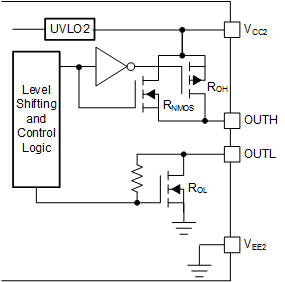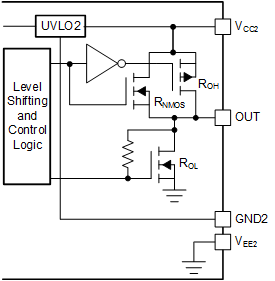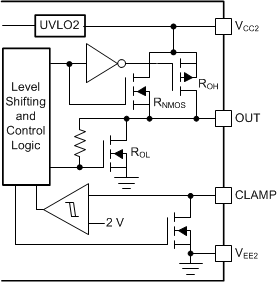SLLSER8J June 2017 – August 2024 UCC5310 , UCC5320 , UCC5350 , UCC5390
PRODUCTION DATA
- 1
- 1 Features
- 2 Applications
- 3 Description
- 4 Device Comparison Table
- 5 Pin Configuration and Function
-
6 Specifications
- 6.1 Absolute Maximum Ratings
- 6.2 ESD Ratings
- 6.3 Recommended Operating Conditions
- 6.4 Thermal Information
- 6.5 Power Ratings
- 6.6 Insulation Specifications for D Package
- 6.7 Insulation Specifications for DWV Package
- 6.8 Safety-Related Certifications For D Package
- 6.9 Safety-Related Certifications For DWV Package
- 6.10 Safety Limiting Values
- 6.11 Electrical Characteristics
- 6.12 Switching Characteristics
- 6.13 Insulation Characteristics Curves
- 6.14 Typical Characteristics
- 7 Parameter Measurement Information
- 8 Detailed Description
- 9 Application and Implementation
- 10Power Supply Recommendations
- 11Layout
- 12Device and Documentation Support
- 13Revision History
- 14Mechanical, Packaging, and Orderable Information
Package Options
Refer to the PDF data sheet for device specific package drawings
Mechanical Data (Package|Pins)
- D|8
- DWV|8
Thermal pad, mechanical data (Package|Pins)
Orderable Information
8.3.3 Output Stage
The output stages of the UCC53x0 family feature a pull-up structure that delivers the highest peak-source current when it is most needed which is during the Miller plateau region of the power-switch turn-on transition (when the power-switch drain or collector voltage experiences dV/dt). The output stage pull-up structure features a P-channel MOSFET and an additional pull-up N-channel MOSFET in parallel. The function of the N-channel MOSFET is to provide a brief boost in the peak-sourcing current, which enables fast turn-on. Fast turn-on is accomplished by briefly turning on the N-channel MOSFET during a narrow instant when the output is changing states from low to high. Table 8-1 lists the typical internal resistance values of the pull-up and pull-down structure.
| DEVICE OPTION | RNMOS | ROH | ROL | RCLAMP | UNIT |
|---|---|---|---|---|---|
| UCC5320SC and UCC5320EC | 4.5 | 12 | 0.65 | Not applicable | Ω |
| UCC5310MC | 4.5 | 12 | 1.3 | 1.3 | Ω |
| UCC5390SC and UCC5390EC | 0.76 | 12 | 0.13 | Not applicable | Ω |
| UCC5350MC | 1.54 | 12 | 0.26 | 0.26 | Ω |
| UCC5350SB | 1.54 | 12 | 0.26 | Not applicable | Ω |
The ROH parameter is a DC measurement and is representative of the on-resistance of the P-channel device only. This parameter is only for the P-channel device, because the pull-up N-channel device is held in the OFF state in DC condition and is turned on only for a brief instant when the output is changing states from low to high. Therefore, the effective resistance of the UCC53x0 pull-up stage during this brief turn-on phase is much lower than what is represented by the ROH parameter, which yields a faster turn-on. The turn-on-phase output resistance is the parallel combination ROH || RNMOS.
The pull-down structure in the UCC53x0 S and E versions is simply composed of an N-channel MOSFET. For the M version, an additional FET is connected in parallel with the pull-down structure when the CLAMP and OUT pins are connected to the gate of the IGBT or MOSFET. The output voltage swing between VCC2 and VEE2 provides rail-to-rail operation.
 Figure 8-6 Output Stage—S Version
Figure 8-6 Output Stage—S Version Figure 8-7 Output Stage—E Version
Figure 8-7 Output Stage—E Version Figure 8-8 Output Stage—M Version
Figure 8-8 Output Stage—M Version